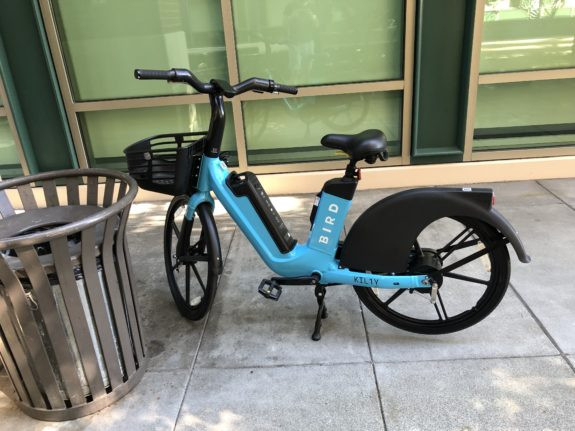Scooter sharing company Bird has expanded its Seattle offerings, quietly introducing shared e-bikes alongside their existing scooter fleet. Naturally, as a cycling enthusiast, I had to find one of these new “Bird Bikes” and take it for a spin to see how they measure up.
These pedal-assist e-bikes from Bird mark the first direct competition for Lime in the Seattle market since Lime’s acquisition of JUMP back in 2020. While Veo also operates “bikes” in Seattle, these are more akin to throttle-controlled scooters with largely ornamental pedals. Bird’s bikes, first unveiled in 2021, are designed to be much more similar to the familiar Lime e-bikes. The pricing structure is set at $1 to unlock and 39¢ per minute, undercutting Lime’s per-minute rate by 8¢ at the time of writing. It’s worth noting that these prices are subject to change and often fluctuate between companies.
 Bird Bike e-bike share in Seattle, a new competitor to Lime for urban transportation.
Bird Bike e-bike share in Seattle, a new competitor to Lime for urban transportation.
My quest to test a Bird bike involved a little searching, but once I got my hands on a fully functional one, the ride was impressive. To put it through its paces, I subjected it to my rigorous downtown hill-climbing test, tackling the notoriously steep inclines of Spring and Seneca Streets between 2nd and 4th Avenues. A bike capable of conquering these hills is ready for any cycling challenge Seattle throws its way.
These distinctive blue and black Bird bikes are equipped with solid tires, a feature reminiscent of the early private bike share programs in Seattle from 2017. Solid tires offer a clear advantage in terms of reliability, eliminating the possibility of flat tires. However, this robustness comes at the cost of ride smoothness, making for a slightly bumpier experience compared to the air-filled tires favored by Lime bikes. The Bird bikes also feature brakes that, while functional for stopping on steep descents, feel somewhat less responsive than ideal. On a positive note, adjusting the saddle height is a breeze thanks to the intuitive dropper post handle, allowing for quick and easy customization.
In a head-to-head comparison, the Bird bike doesn’t quite reach the refined level of the Lime bike, which benefited from JUMP’s extensive experience in bike development. However, the Bird bike holds a significant advantage in price, making the enhanced Lime ride a more premium option. While an 8¢ per minute difference might seem negligible, it accumulates over longer rides. For a 30-minute journey, this price gap widens to $2.40, approaching the cost of a public transit ticket. It will be interesting to observe whether this direct competition from Bird will influence Lime’s pricing strategies, potentially curbing their ongoing price increases.
My initial attempt to locate a Bird Bike on a Friday revealed limited availability across the city. The first bike I found, disappointingly, was not even registered on the app, and the reason quickly became apparent: the battery was missing. Not an encouraging start. Undeterred, I located another bike a few blocks away, this time complete with a battery. However, the ride experience was less than optimal. It was unclear whether it was a bike malfunction or a deliberate speed restriction similar to the 8 mph limit imposed on first-time scooter riders, but the bike seemed to actively resist pedaling beyond approximately 8 mph. Upon ceasing pedaling, the motor disengaged, allowing free rolling, but attempting to pedal again felt akin to applying the brakes. Restarting the trip did not resolve the issue.
Determined to ascertain if this was an isolated incident, I persevered in my Bird bike hunt. After some further searching (GPS locations in the app proved to be somewhat inaccurate in the downtown core, often placing bikes a block away from their actual location), I finally located another bike. This bike performed flawlessly. As expected, the motor provided assistance up to 15 mph, and there was no resistance to pedaling, unlike the previous bike.
The true measure of success for Bird bikes will be their long-term reliability. Encountering difficulties finding a working bike when the fleet was still small does raise some initial concerns. However, hopefully, these are merely teething problems associated with launching a new service. The arrival of more bike share options on Seattle streets is undoubtedly a positive development, reigniting competition in the bike share market for the first time in several years, ultimately benefiting riders with more choices and potentially better prices.

